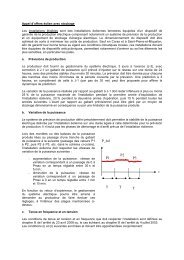Smart Choices for the Smart Grid - Smart Grids
Smart Choices for the Smart Grid - Smart Grids
Smart Choices for the Smart Grid - Smart Grids
Create successful ePaper yourself
Turn your PDF publications into a flip-book with our unique Google optimized e-Paper software.
Addressing <strong>the</strong> challenges of smart grid implementation<br />
Technological advancements have radically altered <strong>the</strong> world’s telecommunications networks over<br />
<strong>the</strong> past decade. Yet ano<strong>the</strong>r important network in our day-to-day lives — <strong>the</strong> energy distribution<br />
grid — has been slower to evolve. That is about to change, however, with <strong>the</strong> proliferation of smart<br />
grid technology.<br />
The smart grid is generally characterized as <strong>the</strong> merger of communications-intensive IT applications<br />
with <strong>the</strong> electric power systems managed by transmission and distribution system operators (TDSOs) —<br />
outfitting 20th century electric grids with 21st century telecommunications technology. The smart<br />
grid’s purpose? To create near-real-time control mechanisms that improve <strong>the</strong> quality of electricity<br />
delivery, reduce carbon emissions, incorporate distributed energy resources, provide automated<br />
demand response and reduce <strong>the</strong> cost of electricity to consumers.<br />
A mature smart grid will comprise a number of integrated yet distinct applications that require varying<br />
degrees of reliability, latency, availability, throughput, security and economic justification (not<br />
only <strong>for</strong> <strong>the</strong> TDSO itself, but also in <strong>the</strong> eyes of public service commissions and municipal councils).<br />
As such, TDSOs face many difficult choices with regard to smart grid implementation — in particular,<br />
which specific technologies should be used to create <strong>the</strong> reliable, two-way communications paths<br />
required <strong>for</strong> <strong>the</strong> operation of <strong>the</strong> smart grid infrastructure and <strong>for</strong> <strong>the</strong> data, video, voice and security<br />
needs of <strong>the</strong> associated applications.<br />
There are few easy answers. Different technologies are better suited than o<strong>the</strong>rs <strong>for</strong> specific smart<br />
grid applications, network geographies and customer demographics. The significant experience of<br />
Alcatel-Lucent in designing and deploying mission-critical wired and wireless broadband solutions<br />
provides unique insight into <strong>the</strong> challenges and choices faced by TDSOs. This paper explores some<br />
of <strong>the</strong> more critical choices — both strategic (how to meet shareholder, regulatory and economic<br />
objectives) and tactical (how <strong>the</strong> trans<strong>for</strong>mation translates into <strong>the</strong> procurement of specific products<br />
and services) — that TDSOs face in weighing <strong>the</strong> merits of implementing wireless broadband services<br />
and trans<strong>for</strong>ming <strong>the</strong> energy distribution infrastructure into a modern smart grid.<br />
Network ownership vs. leasing of commercial services<br />
TDSOs considering smart grid network improvements must first consider <strong>the</strong> advantages and disadvantages<br />
associated with ei<strong>the</strong>r owning <strong>the</strong>ir own network or leasing a network from a commercial<br />
service provider. To maintain control, most TDSOs prefer exclusive ownership of <strong>the</strong> communications<br />
and IT infrastructure supporting <strong>the</strong>ir operational networks. As well, owning <strong>the</strong> network is often<br />
perceived as simpler: embedding commercial services — whe<strong>the</strong>r wireless or leased line — within<br />
an integrated communications network complicates <strong>the</strong> physical and logical connectivity of <strong>the</strong><br />
architecture as well as functions associated with routing, reliability, security, regulatory compliance<br />
and supply chain management.<br />
Owning a private communications network, however, may not be an option <strong>for</strong> all TDSOs <strong>for</strong> reasons<br />
of cost, lack of in-house network design and maintenance skills, or capacity to deploy applications<br />
expeditiously. Moreover, owning such a network can extend technology refresh cycles. Commercial<br />
service providers have extensive experience managing complex technology infusions according to<br />
strict audit and regulatory standards, which allows <strong>the</strong>m to regularly update and integrate new technologies<br />
<strong>for</strong> consumer use. TDSOs can find this difficult to replicate. And while commercial service<br />
providers can share <strong>the</strong> costs of such upgrades among many customers, network-owning TDSOs<br />
must shoulder <strong>the</strong>m alone.<br />
Ultimately, <strong>the</strong> choice of whe<strong>the</strong>r to use commercially available services or to build and maintain<br />
an independent network will be based on each TDSO’s network requirements and <strong>the</strong> associated<br />
costs and business risks.<br />
<strong>Smart</strong> <strong>Choices</strong> <strong>for</strong> <strong>the</strong> <strong>Smart</strong> <strong>Grid</strong> | Technology White Paper 1

















